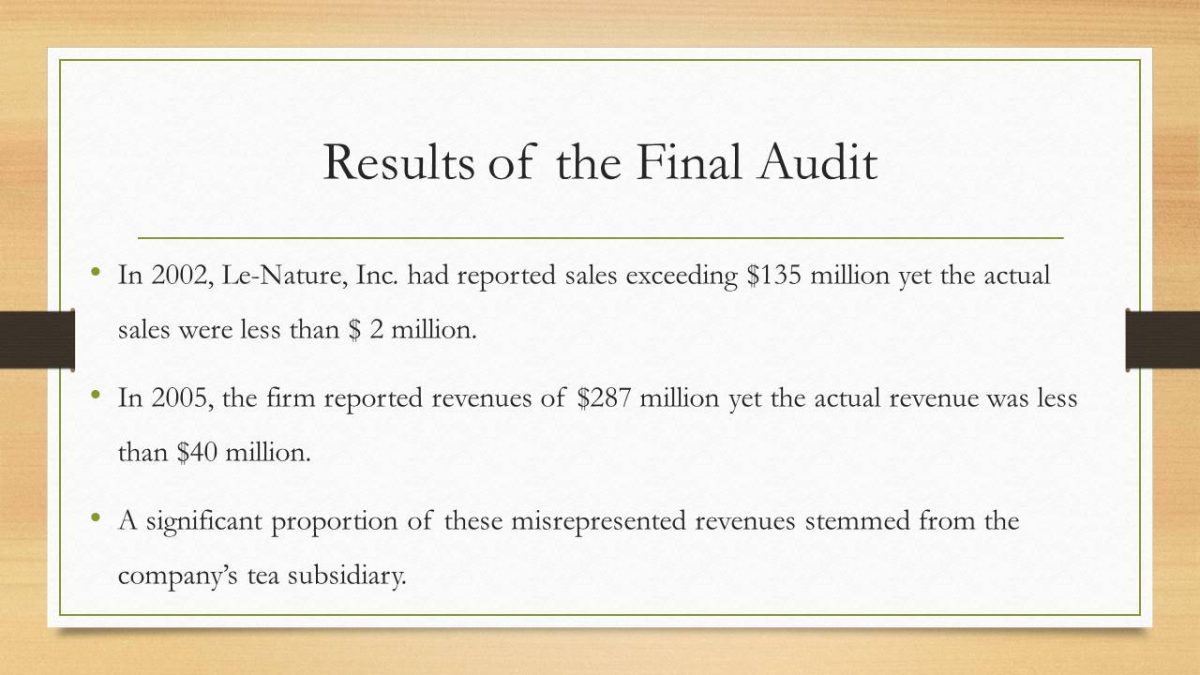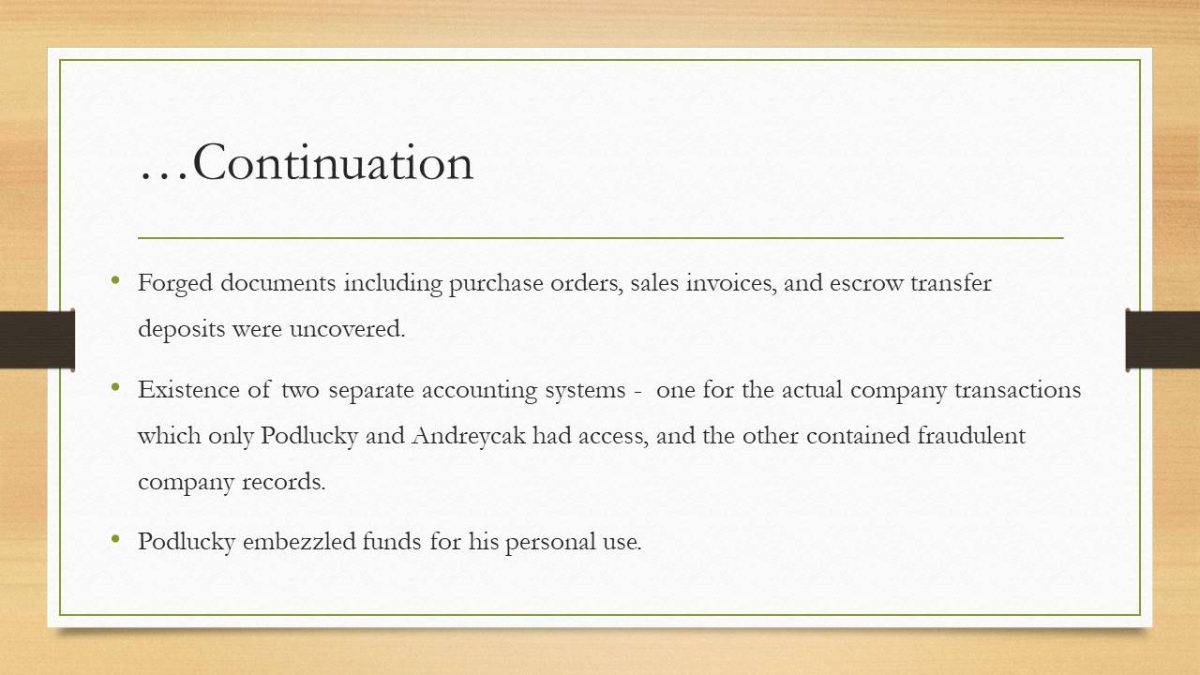Le Nature’s Background
- It was a water-bottling company with headquarters in Latrobe, Pennsylvania.
- It was founded in 1989 by Gregory Podlucky.
- The management team comprised of:
- Chief Executive Office – Gregory Podlucky
- Chief Operating Officer – Jonathan Podllucky, his brother
- Accountant for tea activities – Jesse Podlucky, his son
- Other members of the management team such as Robert Lynn and Tammy Andreycak were friends.
- It was ranked as the 33rd largest beverage company in the U.S. with a revenue of $287 million.
Le-Nature’s, Inc. was founded in 1989 and snowballed to become the U.S. largest beverage producer in 2006, despite the presence of the hypercompetitive beverage industry. The company was managed by a team of individuals that had a close relationship with Podlucky, and these comprised his family and friends. A year earlier, that is, in 2005, the CEO had rejected the offer of selling the company at $1.2 billion, and resort to making it public.
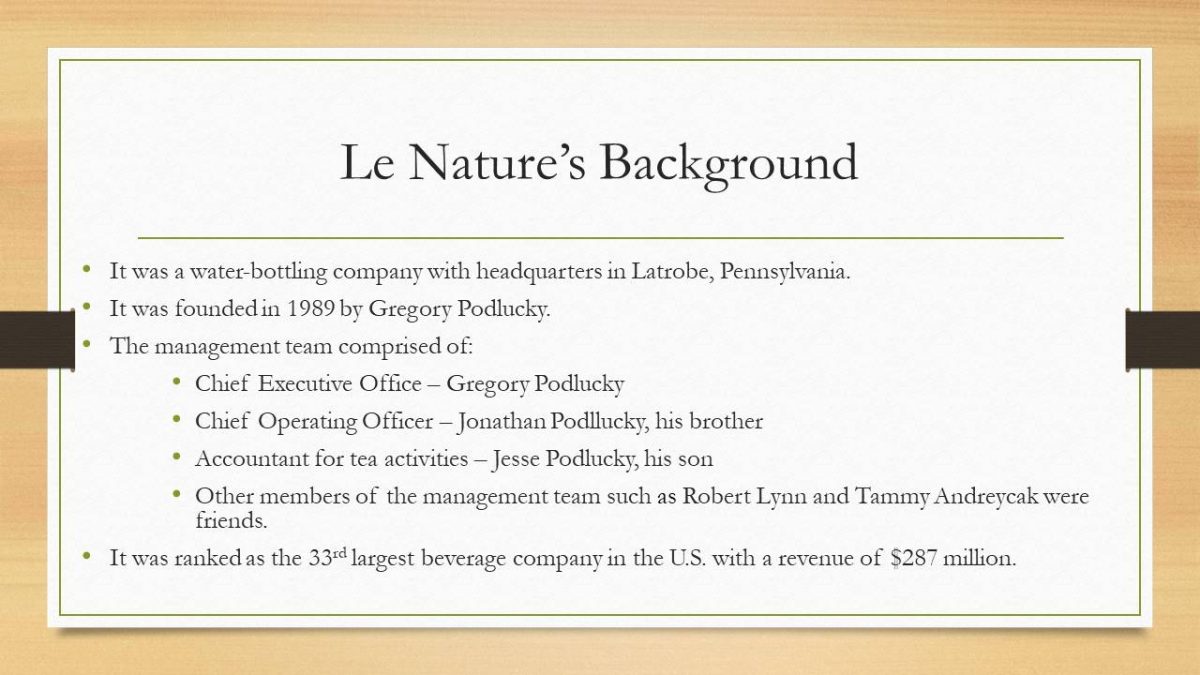
Le-Nature’s Strategic Financing Techniques
They include:
- Long-term borrowing arrangements – Primary method for sourcing funds from Wachovia and Moody’s Investments Services
- The sales of preferred stocks – Raised almost $30 million
- Long-term equipment leasing – Le-Nature retained a North Carolina leasing agent that served as an intermediary that enabled the company to lease equipment from a Wisconsin subsidiary of a German firm
Throughout the 14-year period that Podlucky held the CEO position, he managed to raise approximately $1 billion of debt and equity capital. Since the inadequacy of capital was a rampant issue for growing start-ups, Podlucky resorted to utilizing three strategies to finance Le-Nature’s expanding operations. These comprise the sale of preferred stocks, which raised almost $30 million. This decision significantly affected the company’s corporate governance structure. This is due to the fact that every investment fund that purchased the preferred stock had the mandate to appoint the company board of directors. Therefore, since Podlucky owned all of the company’s outstanding common stock, he ended up selecting his relatives and friends, as shown in the previous slide as the senior company executives.
Second is the long-term borrowing arrangements, which Podlucky used as his primary technique of raising funds. He achieved this by relying on their audited financial statements. For instance, Wachovia, a diversified financial services company located in North Carolina, arranged about $500 million of long-term debt. Moreover, it underwrote a $150 million bond issue. These “junk” bonds were mostly sold to pension and retirement funds.
The third was the long-term equipment leasing technique. Le-Nature used a North Carolina leasing agent that served as an intermediary that enabled the company to lease equipment from a Wisconsin subsidiary of a German firm. The leasing contract needed Le-Nature to make a large escrow deposit with the leasing agent; hence, it borrowed funds from a U.S. lender to facilitate this. This whole agreement was equivalent to approximately $300 million of equipment.
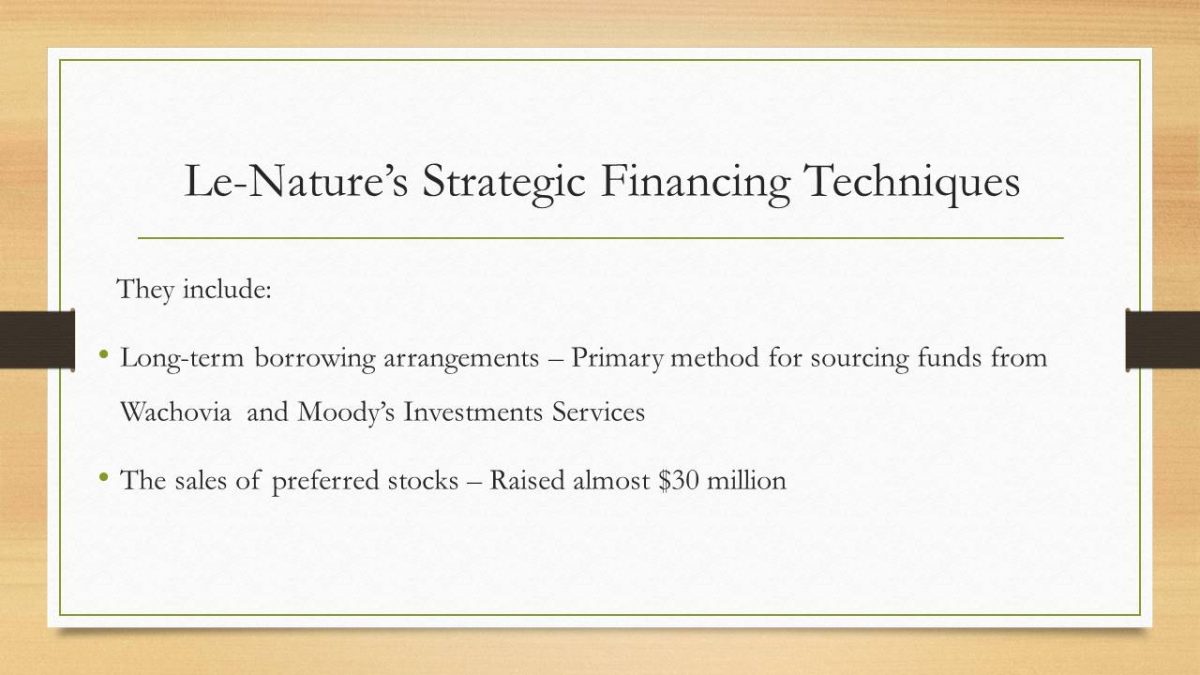
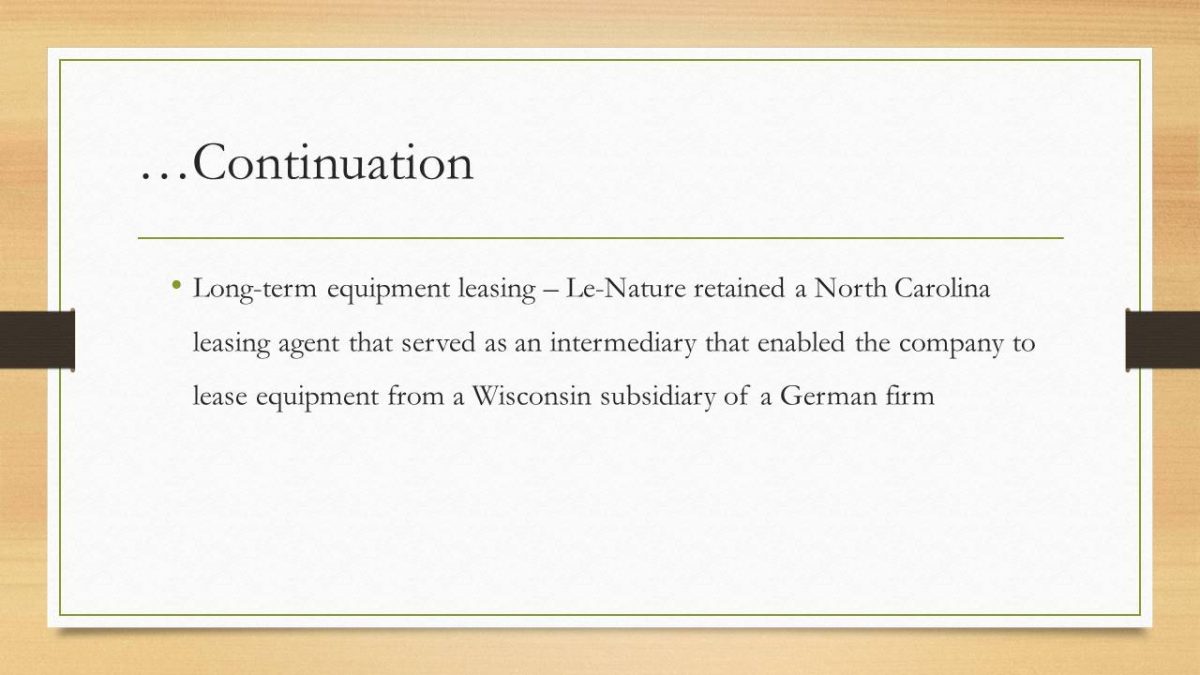
Le-Nature’s, Inc. Red Flags
- Highbee, Le-Nature’s CFO, expressed during an audit that he highly doubted the integrity firm’s recorded sales figures.
- Other two executives, including the CFO, resigned after expressing their doubts.
- Lack of key documentation supporting key transactions present in the accounting records.
- Issues with the internal control:
- Podlucky’s complete control over the firm’s detailed financial records
- Absence of checks and balances for some of the company’s essential assets
- Dismissal of Ernst and Young (EY) as its independent auditing firms
Several red flags indicated fraudulent activity in Le-Nature, Inc. During an independent audit in August 2003, John Highbee, Le-Nature’s Chief Financial Officer, expressed that he highly doubted the reliability of the company’s recorded sales figures. Also, he said that Podlucky failed to provide him with crucial documentation supporting the transactions listed in the accounting records. Therefore, this made him unable to fulfil his corporate governance duties as the CFO. Moreover, after the August 2003 audit, all senior executives who had raised suspicions on Le-Nature’s reported values resigned. This was grounded on the claim that they had participated in improper conduct with the company’s equipment vendors, tea suppliers, and specific customers.
There were also problems with the company’s internal control, in that, since the company contained “inside” senior executives, Podlucky quickly had complete control over the company’s detailed financial records. More so, there was a lack of checks and balances for some of Le-Nature’s, Inc. critical assets, such as the substantial escrow deposits for long-term equipment leases and product inventories.
After the August 2003 audit red flags, Pascarella & Wiker, under the leadership of K & L Gates investigated Le-Nature, Inc. Although the audit identified several internal control weaknesses, they were regarded to be easily rectified. Shortly after, Podlucky fired EY as its independent audit firm and retained BDO Seidman that audited its records from 2003 through to 2005.
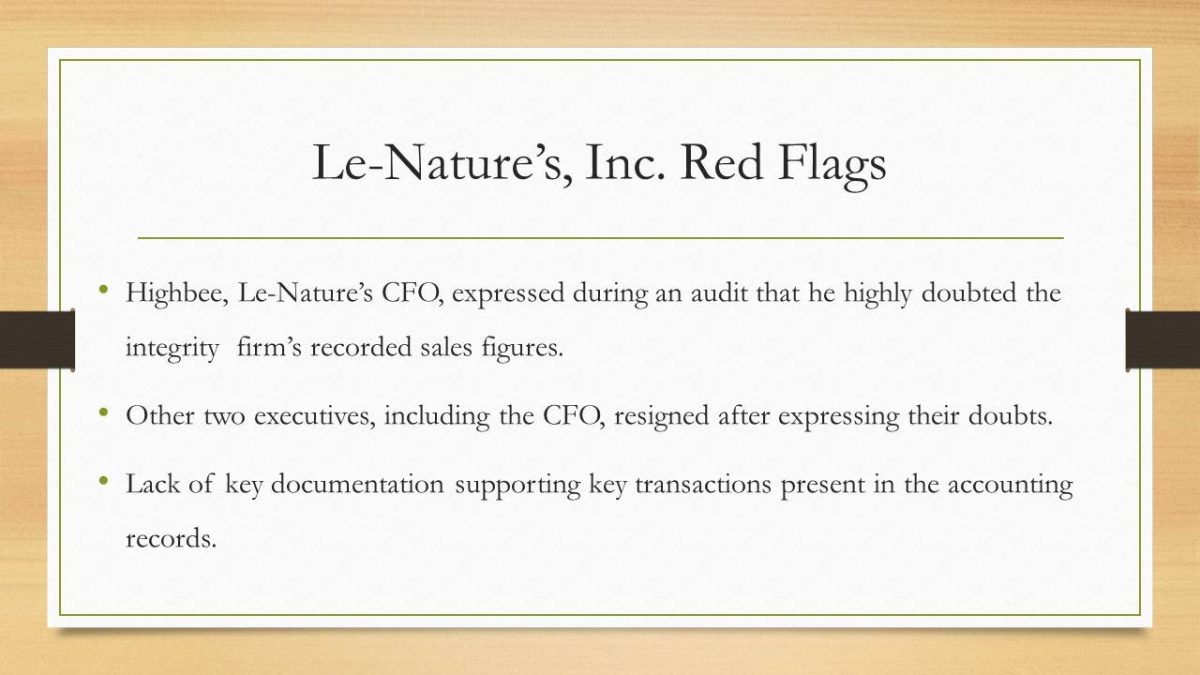

Results of the Final Audit
- In 2002, Le-Nature, Inc. had reported sales exceeding $135 million yet the actual sales were less than $ 2 million.
- In 2005, the firm reported revenues of $287 million yet the actual revenue was less than $40 million.
- A significant proportion of these misrepresented revenues stemmed from the company’s tea subsidiary.
- Forged documents including purchase orders, sales invoices, and escrow transfer deposits were uncovered.
- Existence of two separate accounting systems – one for the actual company transactions which only Podlucky and Andreycak had access, and the other contained fraudulent company records.
- Podlucky embezzled funds for his personal use.
The emergence of lawsuits issued by preferred stakeholders led to the resurfacing of another accounting audit. Law enforcement authorities conducted another investigation, Le-Nature’s court-appointed custodian, and bankruptcy trustee that revealed financial fraud on a grand scale. For instance, from 1990, Podlucky had been misrepresenting reported sales in the financial statements. It is essential to note that a substantial portion of these fraudulent activities was undertaken in the tea subsidiary, which was headed by Jonathan, Podlucky’s son.
Podlucky used the forged documents to source funds for the company from third parties, which he occasionally embezzled to fulfill his lavish lifestyle. Overall, the company’s fraud was resultant of mainly its corporate governance system that enabled the CEO to single-handedly manipulate the financial results. Furthermore, the audit identified that Le-Nature evaded detection by the existence of two accounting systems (one that contained the company’s actual statements and it was only accessible to Podlucky and Andreycak, and the other that listed fraudulent records). Lastly, Podlucky utilized some of the company’s finances to support his lavish lifestyle.
